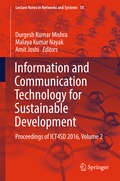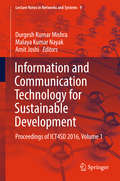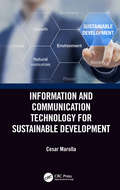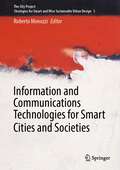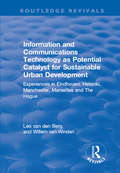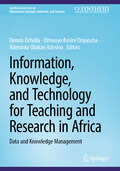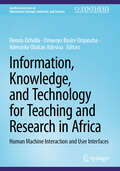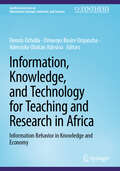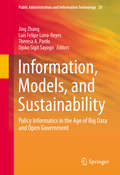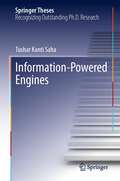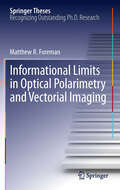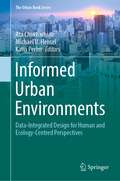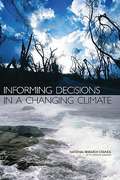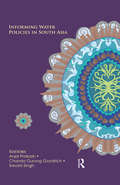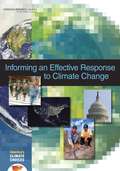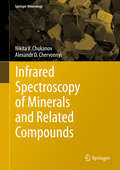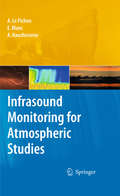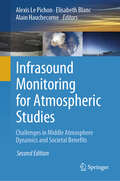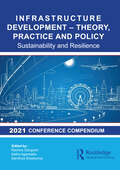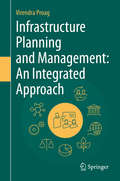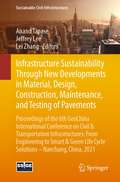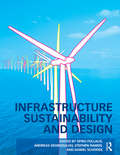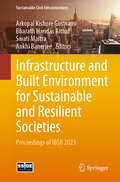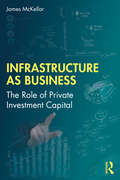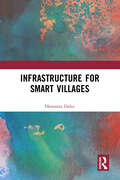- Table View
- List View
Information and Communication Technology for Sustainable Development
by Amit Joshi Durgesh Kumar Mishra Malaya Kumar NayakThe book proposes new technologies and discusses future solutions for design infrastructure for ICT. The book contains high quality submissions presented at Second International Conference on Information and Communication Technology for Sustainable Development (ICT4SD - 2016) held at Goa, India during 1 - 2 July, 2016. The conference stimulates the cutting-edge research discussions among many academic pioneering researchers, scientists, industrial engineers, and students from all around the world. The topics covered in this book also focus on innovative issues at international level by bringing together the experts from different countries.
Information and Communication Technology for Sustainable Development
by Amit Joshi Durgesh Kumar Mishra Malaya Kumar NayakThe book proposes new technologies and discusses future solutions for design infrastructure for ICT. The book contains high quality submissions presented at Second International Conference on Information and Communication Technology for Sustainable Development (ICT4SD - 2016) held at Goa, India during 1 - 2 July, 2016. The conference stimulates the cutting-edge research discussions among many academic pioneering researchers, scientists, industrial engineers, and students from all around the world. The topics covered in this book also focus on innovative issues at international level by bringing together the experts from different countries.
Information and Communication Technology for Sustainable Development
by Cesar MarollaInformation and Communication Technology for Sustainable Development shows how ICT, as an enabler for all spheres of development, can help innovate business processes and operations, and provide faster integration of new technologies into business systems. Focused on sustainability, the book addresses strategic approaches to cope with a range of climatic, environmental, cyber-security threats and other global risks, and aims to promote prosperity and economic growth. Furthermore, it explores how the adoption of new technologies, and collective action based upon a strategic behavioral theory of new leadership, can be applied when responding to specific set of conditions that allow for the proposed strategies to cope with risks. Information technology and strategic planning complement each other to attain the sustainable development goals (SDGs). Risk management frameworks, business continuity systems, and strategic planning methodologies such as mechanism design theory, strategic adaptive cognition (SAC), and risk mechanism theory (RMT) are the fundamental components needed to have a universal approach embedded into the national development plans agenda. As technology no longer follows an orderly, linear path, but improves exponentially, developing a strategic approach to ICT implementation help world leaders in the difficult but inspiring task of making a sustainable world and consequently find solutions to achieve the SDGs and the desired growth pattern that must be sustained, inclusive and equitable. Features: Discusses for the first time the potential of ICT as a transformative power in finding solutions to climatic and economic issues. Illustrates comprehensive strategic planning for leaders to implement in both public and private organizations. Integrates standards and frameworks in the context of sustainable development along with the UN Sustainable Development Goals. Describes in detail how mechanism design, risk management, business continuity systems, a comprehensive strategic planning using SAC (Strategic Adaptive Cognition) and risk mechanism theory can be used to address environmental risks and attain sustainable development goals (SDGs). Explains eHealth as an adaptation strategy to address future changes in climate and impacts, and the links between mitigation and adaptation to ICTs.
Information and Communications Technologies for Smart Cities and Societies (The City Project #5)
by Roberto MenozziThis book offers an overview of digital, IoT and intelligent technologies, applications and solutions that are contributing to shape the digital, inclusive, and sustainable transformation of contemporary cities. Based on peer-reviewed contributions to the workshop "Information and Communications Technologies for Smart Cities and Societies", held on December 2, 2022, at the University of Parma, Italy, it offers a multidisciplinary, authoritative snapshot for researchers, architects, and engineers, as well as professionals and policy makers, involved in planning the city of the future. The book describes practical case studies, discussing challenges and opportunities of the integration of ICTs in the planning and management of future cities.
Information and Communications Technology as Potential Catalyst for Sustainable Urban Development: Experiences in Eindhoven, Helsinki, Manchester, Marseilles and The Hague (Routledge Revivals)
by Leo van Berg Willem van WindenThis title was first published in 2002: The information revolution has deeply influenced the development of Europe’s large cities. They are faced with new opportunities and threats from the information and communication technologies (ICTs) and require strategic policy responses. By examining and comparing five European cities - Eindhoven, Helsinki, Manchester, Marseilles and the Hague - this book sheds light on the impact of ICTs on urban development and considers the consequences for urban management. Case studies show how cities use new technologies to improve the delivery of municipal services, to increase civil participation and local democracy, to help their citizens and businesses make the shift to the information society, and to fight the digital divide . These analyses reveal strategic challenges and potential pitfalls for ICT policy. The book offers a unique international perspective on the impact and potential of information technologies on urban development. The integrative approach - taking economic, social and accessibility issues into account - reveals many new insights.
Information, Knowledge, and Technology for Teaching and Research in Africa: Data and Knowledge Management (Synthesis Lectures on Information Concepts, Retrieval, and Services)
by Dennis Ocholla Omwoyo Bosire Onyancha Aderonke Olaitan AdesinaThis book focuses on data and knowledge management for teaching and research in Africa. The importance of the information and knowledge society in current times is recognized and adopts a meta-analysis to demonstrate that modernization theory could be applied to economic development and rapid transformation of ISWEs in South Africa. The book argues that modernity and the information and knowledge society present the shift and transition from the traditional way of doing things through information and communication technologies (ICTs), which could bring about developing, progressing, and advancing developing communities, particularly Informal Sector Women Entrepreneurs (ISWEs). The book also has further shows how the modernization theory could be applied to the plight of ISWEs to assist them in leapfrogging from their situation and enjoying global business platforms. Various techniques and strategies for collaborative engagements among academics towards strengthening scholarly ties within institutions, and across borders, especially in Africa, are presented. This is a valuable source for understanding the contemporary issues in information and knowledge management/sharing and collaboration among university academics for undergraduates and postgraduate students in the library and information science profession. Tacit knowledge is also presented as an asset that boosts innovation and generates competitive advantage for organizations in all walks of life. Global research data management (RDM) literature is emphasized in higher education institutions (HIEs) and their libraries. The status of RDM services, as well as the competency requirements of employees responsible for providing RDM services and researchers, are addressed in the examined literature.
Information, Knowledge, and Technology for Teaching and Research in Africa: Human Machine Interaction and User Interfaces (Synthesis Lectures on Information Concepts, Retrieval, and Services)
by Dennis Ocholla Omwoyo Bosire Onyancha Aderonke Olaitan AdesinaThis book focuses on human machine interaction and user interfaces for teaching and research in Africa. The importance of digital humanities (DH) is recognized by focusing on the theoretical and historical development of DH in the context of LIS education and how infrastructure influences DH programs/initiatives in respective LIS schools. These findings and recommendations provide valuable knowledge for developing the domain and establishing potential areas of collaboration in DH research and curriculum. The book explores and explicates what the Diffusion of Innovations theory is about as well as the characteristics of innovators. The Diffusion of Innovations theory is relevant to the LIS field, which has widely adopted numerous innovations to automate a wide range of administrative and technical processes, build databases and networks, and provide better services to library users. The diffusion and adoption of technology have become imperative for the efficient management ofmodern libraries and LIS as a field in general. Existing literature that is related to the adoption, use, and challenges facing the development of clinical informatics in teaching hospitals in developing countries is reviewed. It is also revealed that hospitals in developing countries should embrace the use of tools for effective healthcare delivery and that nursing informatics is very significant in nursing practice. In addition, the role of academic institutions and the use of information and communication technologies (ICTs) by librarians for information and knowledge (IKM) in such institutions in the Fourth Industrial Revolution (4IR) is addressed. The book acknowledges the marginalization of indigenous knowledge and that there is a need for Africa to develop and accelerate strategies for enhancing indigenous knowledge for future generation and ICT is poised to play a crucial role.
Information, Knowledge, and Technology for Teaching and Research in Africa: Information Behavior in Knowledge and Economy (Synthesis Lectures on Information Concepts, Retrieval, and Services)
by Dennis Ocholla Omwoyo Bosire Onyancha Aderonke Olaitan AdesinaThis book focuses on information seeking and the knowledge economy for teaching and research in Africa. The book first explores the evolution and current state of information-seeking behavior research, demonstrating its importance in informing practice, policy, and design of information systems. Despite the informal sector’s substantial contributions to the national economy in Uganda, there is a lack of studies delving into its information needs, as well as an information gap in government, NGOs, and other stakeholders. The book proposes that an appropriate information behavior model for information-poor communities such as informal entrepreneurs must be grounded on oral traditions and indigenous knowledge and should be sensitive to poverty, infrastructure, and illiteracy. The negative impact of the lack of financial literacy skills for women entrepreneurs is investigated and solutions for this problem are suggested, including regular assessments of women entrepreneurs’ financial literacy skills and the introduction of training courses. The role of academic libraries in universities, library services for students with disabilities, and accessibility of library services to students with disabilities is discussed, and theoretical models for enhancing service in academic libraries are presented. The book highlights the specific challenges and opportunities related to information literacy for secondary schools and concludes by examining the rapid changes in library and information science research in South Africa.
Information, Models, and Sustainability
by Jing Zhang Luis Felipe Luna-Reyes Theresa A. Pardo Djoko S. SayogoThis book reflects on the emerging trends, development, and challenges of policy on sustainability using information technology, and provides valuable insights to both research and practice communities. Sustainability has become an important focus for government, civil society and the corporate community world-wide. Growing interest in addressing environmental deterioration and associated social inequality and economic challenges is shifting focus to this important issue. The lack of fresh water and arable land, extreme weather, rising cost of relying on fossil fuels, and poverty and regional instability, are drawing attention to the need for government intervention and policy instruments that encourage the development of sustainable alternatives. Governments can play a very important role in facilitating sustainable development through better public policies. First of all, public investments can be directed toward establishing incentives for renewable energy, energy efficiency, sustainable agriculture, and land and water conservation, or toward leveling the field for sustainable alternatives by phasing out the subsidies directed to unsustainable production and development. Second, regulatory and pricing mechanisms could help with the development of markets for sustainable products. This book engages policy informatics analytical and modeling approaches, stakeholder engagement in policy development, implementation and evaluation, and big data and policy informatics to generate valuable insights in the policy on sustainable energy, and will be on interest to researchers in public administration and sustainability, open data and information technology ecological economics.
Information-Powered Engines (Springer Theses)
by Tushar Kanti SahaThis book presents the experimental development of an information-powered engine inspired by the famous thought experiment, Maxwell’s demon, to understand its potential to produce energy for practical purposes. The development of an engine based on Maxwell’s demon was for a long time inconceivable, but technological advances have led to novel investigations into theoretical and practical applications. The built information engine consists of a micron-sized glass bead trapped in a tightly focused laser beam. It rectifies the bead's Brownian motion by controlling the laser's position and generates a unidirectional motion against gravity without doing any work, thus converting thermal heat into stored gravitational potential energy. A theoretical model based on a spring-mass system describes the engine's dynamics and was then used to find optimum parameters to improve the engine's performance. Experimentally implementing these optimization strategies led to engine output powers comparable to those measured in biological motors. This book also highlights performance improvements made in the presence of measurement noise and presents important guiding principles to design information engines to operate in non-equilibrium environments. By focusing on practical applications, the book overall aims to broaden the scope of information-engine investigations.
Informational Limits in Optical Polarimetry and Vectorial Imaging
by Matthew R. ForemanCentral to this thesis is the characterisation and exploitation of electromagnetic properties of light in imaging and measurement systems. To this end an information theoretic approach is used to formulate a hitherto lacking, quantitative definition of polarisation resolution, and to establish fundamental precision limits in electromagnetic systems. Furthermore rigorous modelling tools are developed for propagation of arbitrary electromagnetic fields, including for example stochastic fields exhibiting properties such as partial polarisation, through high numerical aperture optics. Finally these ideas are applied to the development, characterisation and optimisation of a number of topical optical systems: polarisation imaging; multiplexed optical data storage; and single molecule measurements. The work has implications for all optical imaging systems where polarisation of light is of concern.
Informed Urban Environments: Data-Integrated Design for Human and Ecology-Centred Perspectives (The Urban Book Series)
by Katia Perini Michael U. Hensel Ata ChokhachianThis book collects ground-breaking works on the actual and potential impact of big data and data-integrated design for resilient urban environments, including human- and ecology-centred perspectives. Comprehending and designing for urban social, demographic and environmental change is a complex task. Big data, data structuring, data analysis (i.e. AI and ML) and data-integrated design can play a significant role in advancing approaches to this task. The themes presented in this book include urban adaptation, urban morphology, urban mobility, urban ecosystems, urban climate, urban ecology and agriculture. Given the compound nature of complex sustainability problems, most chapters address the correlation between several of these themes. The book addresses practitioners, researchers and graduate students concerned with the rapidly increasing role of data in developing urban environments.
Informing Decisions in a Changing Climate
by National Research Council of the National AcademiesEveryone--government agencies, private organizations, and individuals--is facing a changing climate: an environment in which it is no longer prudent to follow routines based on past climatic averages. State and local agencies in particular, as well as the federal government, need to consider what they will have to do differently if the 100-year flood arrives every decade or so, if the protected areas for threatened species are no longer habitable, or if a region can expect more frequent and more severe wildfires, hurricanes, droughts, water shortages, or other extreme environmental events. Both conceptually and practically, people and organizations will have to adjust what may be life-long assumptions to meet the potential consequences of climate change. How and where should bridges be built? What zoning rules may need to be changed? How can targets for reduced carbon emissions be met? These and myriad other questions will need to be answered in the coming years and decades. Informing Decisions in a Changing Climate examines the growing need for climate-related decision support--that is, organized efforts to produce, disseminate, and facilitate the use of data and information in order to improve the quality and efficacy of climate-related decisions. Drawing on evidence from past efforts to organize science for improved decision making, it develops guidance for government agencies and other institutions that will provide or use information for coping with climate change. This volume provides critical analysis of interest to agencies at every level, as well as private organizations that will have to cope with the world's changing climate.
Informing Water Policies in South Asia
by Anjal Prakash Chanda Gurung Goodrich Sreoshi SinghThis book analyzes water policies in South Asia from the perspective of Integrated Water Resources Management (IWRM). It seeks to address the problems of water scarcity, conflict and pollution resulting from the gross mismanagement and over-exploitation of this finite resource. Highlighting the need for IWRM in mitigating abuse and ensuring sustainable use, it discusses issues relating to groundwater management; inter-state water conflicts; peri-urban water use; local traditional water management practices; coordination between water users and uses; and water integration at the grassroots level. With case studies from India, Bangladesh, Pakistan, and Nepal, the innovative, painstaking and transnational researches presented in the volume deal with questions of equity, gender, sustainability, and democratic governance in water policy interventions. It will interest researchers and students of development studies, environmental studies, natural resource management, water governance, and public administration, as also water sector professionals, policymakers, civil society activists and governmental and nongovernmental organizations.
Informing an Effective Response to Climate Change
by National Research Council of the National AcademiesGlobal climate change is one of America's most significant long-term policy challenges. Human activity--especially the use of fossil fuels, industrial processes, livestock production, waste disposal, and land use change--is affecting global average temperatures, snow and ice cover, sea-level, ocean acidity, growing seasons and precipitation patterns, ecosystems, and human health. Climate-related decisions are being carried out by almost every agency of the federal government, as well as many state and local government leaders and agencies, businesses and individual citizens. Decision makers must contend with the availability and quality of information, the efficacy of proposed solutions, the unanticipated consequences resulting from decisions, the challenge of implementing chosen actions, and must consider how to sustain the action over time and respond to new information. Informing an Effective Response to Climate Change, a volume in the America's Climate Choices series, describes and assesses different activities, products, strategies, and tools for informing decision makers about climate change and helping them plan and execute effective, integrated responses. It discusses who is making decisions (on the local, state, and national levels), who should be providing information to make decisions, and how that information should be provided. It covers all levels of decision making, including international, state, and individual decision making. While most existing research has focused on the physical aspect of climate change, Informing an Effective Response to Climate Change employs theory and case study to describe the efforts undertaken so far, and to guide the development of future decision-making resources. Informing an Effective Response to Climate Change offers much-needed guidance to those creating public policy and assists in implementing that policy. The information presented in this book will be invaluable to the research community, especially social scientists studying climate change; practitioners of decision-making assistance, including advocacy organizations, non-profits, and government agencies; and college-level teachers and students.
Infrared Spectroscopy of Minerals and Related Compounds (Springer Mineralogy)
by Nikita V. Chukanov Alexandr D. ChervonnyiThis book provides an overview of the application of IR spectroscopy in mineralogical investigations, as well as modern trends in the IR spectroscopy of minerals. It includes the most important methodological aspects; characteristic IR bands of different chemical groups and coordination polyhedra; application of IR spectroscopy to the investigation of the crystal chemistry of amphiboles, phyllosilicates, tourmalines etc.; neutral molecules entrapped by microporous minerals; and analysis of hydrogen in nominally anhydrous minerals. About 1600 IR spectra (illustrations as well as a list of wavenumbers) of minerals and some related compounds are accompanied by detailed descriptions of the standard samples used. Each spectrum provides information about the occurrence, appearance, associated minerals, its empirical formula, and unit-cell parameters. The book also provides insights into sample preparation and/or spectrum registration methods. It includes IR spectra of 1020 minerals that were not covered in the book “Infrared spectra of mineral species: Extended library” published in 2014 and written by one of the authors. On average, each page provides information on two minerals/compounds. Subsections correspond to different classes of compounds (silicates, phosphates, arsenates, oxides etc.). About 290 new spectra have been obtained, and the remaining 1310 spectra are taken from most reliable literature sources (published over the last 60 years) and are redrawn in a unified style.
Infrasound Monitoring for Atmospheric Studies
by Alain Hauchecorne Alexis Le Pichon Elisabeth BlancThe infrasound field, the science of low-frequency acoustic waves, has developed into a broad interdisciplinary field encompassing academic disciplines of physics and recent technical and scientific developments. In 1996, the United Nations General Assembly adopted the Comprehensive Nuclear-Test-Ban Treaty (CTBT), prohibiting atmospheric nuclear explosions worldwide. The infrasound network of the International Monitoring Network (IMS) of the CTBT-Organization has demonstrated its capability for detecting and locating infrasonic sources such as meteorites, volcanic eruptions, earthquakes, auroras, mountain associated waves... Nearly 70% of the global network is now operational and regional cluster arrays are deployed around the globe. Systematic investigations into low-frequency acoustic signals have evidenced an unprecedented potential of the monitoring of infrasonic waves permanently generated by natural and man-made events. Furthermore, recent studies point out new insights on quantitative relationships between observables and atmospheric specifications, and therefore opening new fields into the mathematics of geophysical inverse problems for atmospheric remote sensing. This volume reviews the most important areas of infrasound, with emphasis on the latest researches and applications, e.g. instrumentation, engineering, signal processing, source monitoring, propagation modeling, atmospheric dynamics, global changes, remote sensing methods. Researchers and students will benefit from a comprehensive content of infrasound related topics, where both fundamental and applied topics are discussed by authors from international institutions, all experts in their fields.
Infrasound Monitoring for Atmospheric Studies: Challenges in Middle Atmosphere Dynamics and Societal Benefits
by Alain Hauchecorne Alexis Le Pichon Elisabeth BlancSince the publication of the first volume “Infrasound monitoring for atmospheric studies” published in 2010, significant advances were achieved in the fields of engineering, propagation modelling, and atmospheric remote sensing methods. The global infrasound network, which consists of the International Monitoring Network (IMS) for nuclear test ban verification completed by an increasing number of regional cluster arrays deployed around the globe, has evidenced an unprecedented potential for detecting, locating and characterizing various natural and man-made sources. In recent years, infrasound has evolved into a broad interdisciplinary field encompassing academic disciplines of geophysics and innovative technical and scientific developments. The advances in innovative ground-based instruments, including infrasound inversions for continuous observations of the stratosphere and mesosphere, provide useful insights into the geophysical source phenomenology and atmospheric processes involved. Systematic investigations into low-frequency infrasound signals and the development of complementary observational platforms point out new insights into the dynamics of the middle atmosphere which play a significant role in both tropospheric weather and climate. This monitoring system also provides continuous relevant information about natural hazards with high societal benefits, like on-going volcanic eruptions, surface earthquakes, meteorites or severe weather. With this new edition, researchers and students benefit from a comprehensive content of both fundamental and applied inter-disciplinary topics.
Infrastructure Development – Theory, Practice and Policy: Sustainability and Resilience
by Rachna Gangwar Sandhya Sreekumar Astha AgarwallaThis compendium presents the papers presented in the conference 'Infrastructure Development Theory, Practice, and Policy' held on 29th and 30th April, 2021. It brings together the select papers from the conference and other contributions from experts and researchers. The compendium puts together the research under various themes, and we hope that the theoretical findings will impact the practice and policy in the future, as well as pave the way for future research in the direction of achieving more efficient, and more humane infrastructure.
Infrastructure Planning and Management: An Integrated Approach
by Virendra ProagThis book explains how water, electricity/power, roads and other infrastructure services are linked together within the general basket of development and how to obtain the optimum use of resources. The emphasis, nowadays, is on multipurpose activities, optimum use of resources, environmental approach, minimum use of energy. This book tries to integrate all of these, by showing the links between the different components of infrastructure and trying to model them. A well articulated, socially attractive and desirable project may fail during the implementation or operation stage, not only from bad design, but also due to inadequate attention paid to the human aspects required for its operation. This book is intended for graduates and practising professionals who are involved in the general development planning of their country/region. It enables better understanding, collaboration and communication with other professionals in relation to their own or different disciplines.
Infrastructure Sustainability Through New Developments in Material, Design, Construction, Maintenance, and Testing of Pavements: Proceedings of the 6th GeoChina International Conference on Civil & Transportation Infrastructures: From Engineering to Smart & Green Life Cycle Solutions -- Nanchang, China, 2021 (Sustainable Civil Infrastructures)
by Jeffrey Lee Lei Zhang Anand TapaseThis book includes a collection of research and practical papers aiming with key priority for improving the infrastructural sustainability for our well-being and day-to-day lives through novel developments. The united efforts through new developments in material, design, construction, maintenance, and testing of pavements from all over the world are taken under one umbrella. Topics include issues related to civil infrastructure such as the use of construction waste, recycled aggregates, service life prediction of pavements, mechanical behavior of SMA, control measures of ready mixed concrete, determination of landslide high-risk areas, Simulation of rock hydraulics in rock joint, sustainable planning for provision of basic infrastructural facilities in rural areas. It is anticipated that this book will support decisions regarding the optimal management and maintenance of civil infrastructures to support a more resilient and sustainable environment for infrastructure users.
Infrastructure Sustainability and Design
by Andreas Georgoulias Daniel Schodek Spiro Pollalis Stephen RamosYou're overseeing a large-scale project, but you're not an engineering or construction specialist, and so you need an overview of the related sustainability concerns and processes. To introduce you to the main issues, experts from the fields of engineering, planning, public health, environmental design, architecture, and landscape architecture review current sustainable large-scale projects, the roles team members hold, and design approaches, including alternative development and financing structures. They also discuss the challenges and opportunities of sustainability within infrastructural systems, such as those for energy, water, and waste, so that you know what's possible. And best of all, they present here for the first time the Zofnass Environmental Evaluation Methodology guidelines, which will help you and your team improve infrastructure design, engineering, and construction.
Infrastructure and Built Environment for Sustainable and Resilient Societies: Proceedings of IBSR 2023 (Sustainable Civil Infrastructures)
by Arkopal Kishore Goswami Bharath Haridas Aithal Swati Maitra Ankhi BanerjeeThis book presents the select proceedings of the Annual Conference on "Infrastructure and Built Environment: Towards Sustainable and Resilient Societies" (IBSR 2023). It covers the latest research and technologies in the area of smart and sustainable built environment for inclusive societies. Various topics covered in this volume are multimodal urban transport, spatial informatics in urban planning, urban morphology, sustainable transport infrastructure development and many more. This book will be useful for researchers and professionals working in the fields of urban mobility, affordable housing, road infrastructure, and spatial informatics.
Infrastructure as Business: The Role of Private Investment Capital
by James McKellarInfrastructure as Business brings new emphasis and clarity to the importance of private investment capital in large-scale infrastructure projects, introducing investors, policymakers, and other stakeholders to a key element that is surprisingly absent from the discourse on public-private partnerships. Despite the importance of modernizing infrastructure across the globe, governments often face challenges in securing the necessary capital to meet future need, as well as developing policy to meet these goals. Explaining the structure of the private investment universe and flow of private capital in such projects, this book ambitiously aims to bridge this "infrastructure gap" by elucidating shared terminology, conceptual frameworks, and an alignment of goals and objectives between public and private sectors—essential to meet increasing environmental, social, and governmental requirements for infrastructure in coming years. Appropriate for graduate-level courses in real estate, public policy, and urban planning that focus on infrastructure, project finance, and procurement and delivery models such as PPPs. Provides a clear understanding of private investment and PPPs to the investment community as well as professionals in real estate, project finance, and related fields, who often learn mostly on-the-job and from colleagues. Equips government officials and policymakers with key terms and concepts needed to "sit across the table" with private financers and explore opportunities for private capital investment in early project stages. Outlines communication strategies for both public and private sectors, which will increasingly need to collaborate to address climate change, respond to new technologies, and develop efficient ways to deliver services. Written to engage academic, private investment, and public policy/governance audiences alike, Infrastructure as Business: The Role of Private Investment Capital invites discussion and opens doors to advancing new business models, with international applications, to offer increased value for private investors as well as more efficient, flexible funding for innovative infrastructure development in the future.
Infrastructure for Smart Villages
by Hemanta DoloiThis book intends to initiate a fresh articulation of need-based infrastructure provisions in rural contexts. Departing from the conventional theories and practices of infrastructure planning and development applied in urban settings, the book presents a comprehensive suite of technical and non-technical indicators that rationalise fit-for-purpose planning, development, and operations of rural infrastructure. Drawing from global practices in public and private sectors and research-based evidence, a distinctive argument is put forward for promoting location-specific infrastructure development from effectiveness, practicality, affordability, and sustainability perspectives. The argument encompasses wider social, cultural, and economic contexts that are unique to rural settings and the book highlights a clear roadmap of how the UN’s sustainable development goals (SDGs) are at the core of developing rural communities with necessary infrastructure provisions that are purpose-built, affordable, risk averse, and resilient.This book will provide an overview of some of the little-understood and sometimes counter-intuitive best practices on rural infrastructure and value-based priorities that have emerged in uplifting rural communities in developing economies over the last 30 years. Drawing from the global literature and practice-based evidence across a complete spectrum of relevant disciplines, this book will provide readers with a clear articulation of the innovative ideas around harnessing rural potential, and empowering rural communities with added support in growth and progressive development in the context of interconnected infrastructure systems and improved living standards. It is key reading for development, planning, and infrastructure courses as well as professionals and researchers involved in international development, aid, and provision in rural areas.
